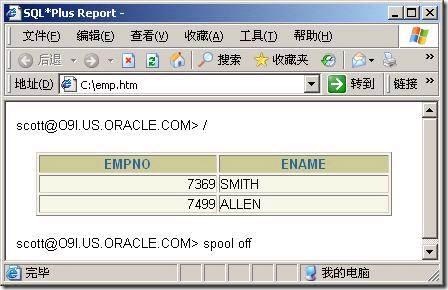sqlplus的小秘密[轉]
?
??? 今天看到一個帖子,學了幾個SQLPLUS的小技巧。說實話還挺不錯的,確實沒有花時間看過Oracle關于SQLPLUS的文檔,總覺得有點浪費時間,呵呵,不過這樣知識就永遠掌握得不牢靠,忘記了要去查,不過要能抽出時間看這種文檔,估計要等1-2年之后了。
?
?
?
1、顯示空格
?
有沒有為了dbms_output.put_line會"吃掉"最前面的空格而苦惱?
?
SQL> set serveroutput on
SQL> exec dbms_output.put_line('?? abc');
abc
SQL> exec dbms_output.put_line('?? abc');
abc
?
PL/SQL procedure successfully completed.
?
?
(俺以前曾經很苦惱為了保留空格, 嘗試了加".", 加不可見字符等辦法, 不過終究覺得不自然)
實際上, 只要在set serveroutput on后加上format wrapped參數, 就可以避免這個問題
實際上, 只要在set serveroutput on后加上format wrapped參數, 就可以避免這個問題
?
SQL> set serveroutput on format wrapped
SQL> exec dbms_output.put_line('?? abc');
?? abc
SQL> exec dbms_output.put_line('?? abc');
?? abc
?
PL/SQL procedure successfully completed.
?
?
?
2、SQL語句中的空行
?
Sql*plus中, 不允許sql語句中間有空行, 這在從其它地方拷貝腳本到sql*plus中執行時很麻煩. 比如下面的腳本:
?
select deptno, empno, ename
from emp
from emp
?
where empno = '7788';
如果拷貝到sql*plus中執行, 就會出現錯誤:
如果拷貝到sql*plus中執行, 就會出現錯誤:
?
SQL> select deptno, empno, ename
? 2? from emp
? 3
SQL> where empno = '7788';
SP2-0734: unknown command beginning "where empn..." - rest of line ignored.
?
原因是sqlplus遇到空行就認為是語句結束了.
其實要改變這種現象, 只要使用SQLBLANKLINES參數就可以了.
其實要改變這種現象, 只要使用SQLBLANKLINES參數就可以了.
?
SQL>
SET SQLBLANKLINES ON
SQL> select deptno, empno, ename
? 2? from emp
? 3
? 4? where empno = '7788';
SQL> select deptno, empno, ename
? 2? from emp
? 3
? 4? where empno = '7788';
?
??? DEPTNO????? EMPNO ENAME
---------- ---------- ----------
??????? 20?????? 7788 SCOTT
---------- ---------- ----------
??????? 20?????? 7788 SCOTT
?
?
?
3、 # 的應用
?
?
??? 有沒有過這樣的經歷? 在sql*plus中敲了很長的命令后, 突然發現想不起某個列的名字了, 如果取消當前的命令,待查詢后再重敲, 那太痛苦了. 當然你可以另開一個sql*plus窗口進行查詢, 但這里提供的方法更簡單。這種情況下, 只要在下一行以#開頭, 就可以執行一條sql*plus命令, 執行完后, 剛才的語句可以繼續輸入
?
SQL> select deptno,
? 2? empno,
? 3? ename
? 4? from emp
? 5? where
? 6? #desc emp
Name????????????????????????????????????? Null???? Type
----------------------------------------- -------- --------------
?
EMPNO???????????????????????????????????? NOT NULL NUMBER(4)
ENAME????????????????????????????????????????????? VARCHAR2(10)
JOB??????????????????????????????????????????????? VARCHAR2(9)
MGR??????????????????????????????????????????????? NUMBER(4)
HIREDATE?????????????????????????????????????????? DATE
SAL??????????????????????????????????????????????? NUMBER(7,2)
COMM?????????????????????????????????????????????? NUMBER(7,2)
DEPTNO???????????????????????????????????????????? NUMBER(2)
ENAME????????????????????????????????????????????? VARCHAR2(10)
JOB??????????????????????????????????????????????? VARCHAR2(9)
MGR??????????????????????????????????????????????? NUMBER(4)
HIREDATE?????????????????????????????????????????? DATE
SAL??????????????????????????????????????????????? NUMBER(7,2)
COMM?????????????????????????????????????????????? NUMBER(7,2)
DEPTNO???????????????????????????????????????????? NUMBER(2)
?
? 6? sal > 4000;
?
??? DEPTNO????? EMPNO ENAME
---------- ---------- ----------
??????? 10?????? 7839 KING
---------- ---------- ----------
??????? 10?????? 7839 KING
?
?
?
?
4、以html格式展現輸出
?
sql*plus中有一個set markup html的命令, 可以將sql*plus的輸出以html格式展現
?
SQL> set markup html on spool on
SQL> select empno, ename from emp where rownum<3;
<br>
<p>
<table border='1' width='90%' align='center' summary='Script output'>
<tr>
<th scope="col">
EMPNO
</th>
<th scope="col">
ENAME
</th>
</tr>
<tr>
<td align="right">
7369
</td>
<td>
SMITH
</td>
</tr>
<tr>
<td align="right">
7499
</td>
<td>
ALLEN
</td>
</tr>
</table>
<p>
SQL>
注意其中的spool on, 當在屏幕上輸出的時候, 我們看不出與不加spool on有什么區別, 但是當我們使用spool filename 輸出到文件的時候, 會看到spool文件中出現了<html><body>等tag.
?
SQL> spool c:\emp.htm
<br>
SQL> /
<br>
<p>
<table border='1' width='90%' align='center' summary='Script output'>
... ...
<br>
SQL> /
<br>
<p>
<table border='1' width='90%' align='center' summary='Script output'>
... ...
?
SQL> spool off
<br>
<br>
查看生成的emp.htm文件的內容:
?
<html>
<head>
<meta http-equiv="Content-Type" content="text/html; charset=WINDOWS-936">
<meta name="generator" content="SQL*Plus 9.2.0">
<style type='text/css'> body {font:10pt Arial,Helvetica,sans-serif; color:black; background:White;} p {font:10pt Arial,Helvetica,sans-serif; color:black; background:White;} table,tr,td {font:10pt Arial,Helvetica,sans-serif; color:Black; background:#f7f7e7; padding:0px 0px 0px 0px; margin:0px 0px 0px 0px;} th {font:bold 10pt Arial,Helvetica,sans-serif; color:#336699; background:#cccc99; padding:0px 0px 0px 0px;} h1 {font:16pt Arial,Helvetica,Geneva,sans-serif; color:#336699; background-color:White; border-bottom:1px solid #cccc99; margin-top:0pt; margin-bottom:0pt; padding:0px 0px 0px 0px;} h2 {font:bold 10pt Arial,Helvetica,Geneva,sans-serif; color:#336699; background-color:White; margin-top:4pt; margin-bottom:0pt;} a {font:9pt Arial,Helvetica,sans-serif; color:#663300; background:#ffffff; margin-top:0pt; margin-bottom:0pt; vertical-align:top;}</style><title>SQL*Plus Report</title>
</head>
<body>
SQL> /
<br>
<p>
<table border='1' width='90%' align='center' summary='Script output'>
<tr>
<th scope="col">
EMPNO
</th>
<th scope="col">
ENAME
</th>
</tr>
<tr>
<td align="right">
7369
</td>
<td>
SMITH
</td>
</tr>
<tr>
<td align="right">
7499
</td>
<td>
ALLEN
</td>
</tr>
</table>
<p>
<head>
<meta http-equiv="Content-Type" content="text/html; charset=WINDOWS-936">
<meta name="generator" content="SQL*Plus 9.2.0">
<style type='text/css'> body {font:10pt Arial,Helvetica,sans-serif; color:black; background:White;} p {font:10pt Arial,Helvetica,sans-serif; color:black; background:White;} table,tr,td {font:10pt Arial,Helvetica,sans-serif; color:Black; background:#f7f7e7; padding:0px 0px 0px 0px; margin:0px 0px 0px 0px;} th {font:bold 10pt Arial,Helvetica,sans-serif; color:#336699; background:#cccc99; padding:0px 0px 0px 0px;} h1 {font:16pt Arial,Helvetica,Geneva,sans-serif; color:#336699; background-color:White; border-bottom:1px solid #cccc99; margin-top:0pt; margin-bottom:0pt; padding:0px 0px 0px 0px;} h2 {font:bold 10pt Arial,Helvetica,Geneva,sans-serif; color:#336699; background-color:White; margin-top:4pt; margin-bottom:0pt;} a {font:9pt Arial,Helvetica,sans-serif; color:#663300; background:#ffffff; margin-top:0pt; margin-bottom:0pt; vertical-align:top;}</style><title>SQL*Plus Report</title>
</head>
<body>
SQL> /
<br>
<p>
<table border='1' width='90%' align='center' summary='Script output'>
<tr>
<th scope="col">
EMPNO
</th>
<th scope="col">
ENAME
</th>
</tr>
<tr>
<td align="right">
7369
</td>
<td>
SMITH
</td>
</tr>
<tr>
<td align="right">
7499
</td>
<td>
ALLEN
</td>
</tr>
</table>
<p>
?
SQL> spool off
<br>
</body>
</html>
<br>
</body>
</html>
?
用ie打開emp.htm文件后的樣式如下:
?
?
?
現在看看spool off的情況下:
?
SQL> set markup html on spool off
<br>
SQL> spool c:\emp2.htm
<br>
SQL> /
<br>
<p>
<table border='1' width='90%' align='center' summary='Script outpu
... ...
<br>
SQL> spool c:\emp2.htm
<br>
SQL> /
<br>
<p>
<table border='1' width='90%' align='center' summary='Script outpu
... ...
SQL> spool off
<br>
<br>
?
查看生成的emp2.htm文件的內容:
?
SQL> /
<br>
<p>
<table border='1' width='90%' align='center' summary='Script output'>
<tr>
<th scope="col">
EMPNO
</th>
<th scope="col">
ENAME
</th>
</tr>
<tr>
<td align="right">
7369
</td>
<td>
SMITH
</td>
</tr>
<tr>
<td align="right">
7499
</td>
<td>
ALLEN
</td>
</tr>
</table>
<p>
<br>
<p>
<table border='1' width='90%' align='center' summary='Script output'>
<tr>
<th scope="col">
EMPNO
</th>
<th scope="col">
ENAME
</th>
</tr>
<tr>
<td align="right">
7369
</td>
<td>
SMITH
</td>
</tr>
<tr>
<td align="right">
7499
</td>
<td>
ALLEN
</td>
</tr>
</table>
<p>
?
SQL> spool off
?
由于這段代碼中沒有html文件頭, 所以我們可以直接作為內容插入到網頁中
總結: 如果要生成一個完整的html文件, 就使用spool on選項, 如果只是要內容部分(用來添加到一個現有的網頁中), 那么就使用spool off選項.
?
另外, set markup html還有很多選項可以用來定制生成的html的各個部分, 例如head, body, table等, 這里不再逐一說明, 詳細信息可以參考SQL*Plus User's Guide and Reference.
?
適用場景: 當需要定時更新一個從數據庫中獲取內容的靜態頁面時, 這種方法絕對是快捷的并且容易實現的.



